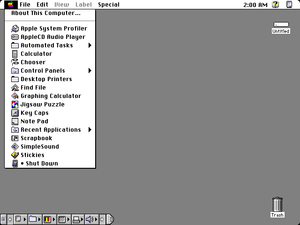Mac System 7
| A version of the classic Mac OS operating system | |

Screenshot of Mac OS 7.6.1
|
|
| Developer | Apple Computer |
|---|---|
| OS family | Macintosh |
| Working state | Historic, not supported |
| Source model | Closed source |
| Initial release | May 13, 1991 |
| Latest release | 7.6.1 / April 7, 1997 |
| Kernel type | Monolithic for 68k, nanokernel for PowerPC |
| License | Proprietary |
| Preceded by | System 6 |
| Succeeded by | Mac OS 8 |
| Official website | Mac OS Releases at the Wayback Machine (archived April 12, 1997) |
| Support status | |
| Unsupported as of the end of 2001 | |
System 7 (codenamed "Big Bang" and sometimes retrospectively called Mac OS 7) is a single-user graphical user interface-based operating system for Macintosh computers and was part of the classic Mac OS line of operating systems. It was introduced on May 13, 1991, by Apple Computer. It succeeded System 6, and was the main Macintosh operating system until it was succeeded by Mac OS 8 in 1997. Features added with the System 7 release included virtual memory, personal file sharing, QuickTime, QuickDraw 3D, and an improved user interface.
"System 7" is often used generically to refer to all 7.x versions. With the release of version 7.6 in 1997, Apple officially renamed the operating system "Mac OS", a name which had first appeared on System 7.5.1's boot screen. System 7 was developed for Macs that used the Motorola 680x0 line of processors, but was ported to the PowerPC after Apple adopted the new processor.
The development of the Macintosh "Systems" up to System 6 followed a fairly smooth progression with the addition of new features and relatively small changes and upgrades over time. Major additions were fairly limited, notably adding Color QuickDraw and MultiFinder in System 6. Some perspective on the scope of the changes can be seen by examining the official system documentation, Inside Macintosh. This initially shipped in three volumes, adding another to describe the changes introduced with the Mac Plus, and another for the Mac II and Mac SE.
...
Wikipedia
